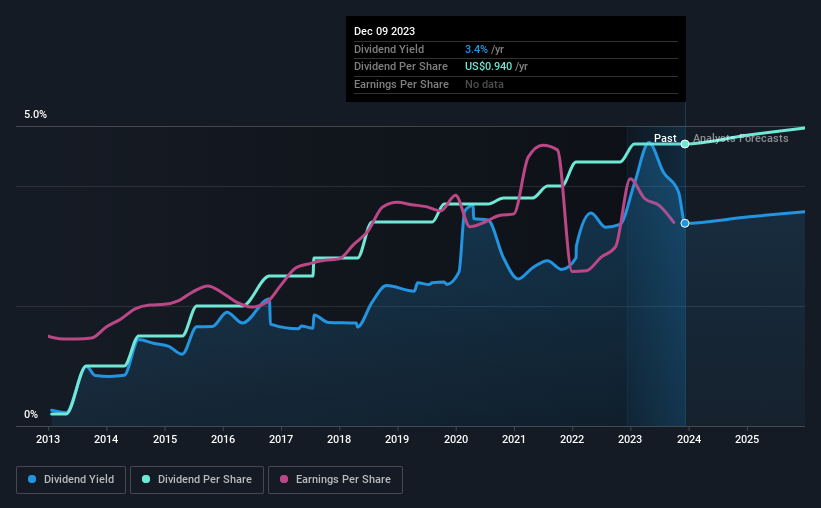Why You Might Be Interested In Cadence Bank (NYSE:CADE) For Its Upcoming Dividend
Some investors rely on dividends for growing their wealth, and if you're one of those dividend sleuths, you might be intrigued to know that Cadence Bank (NYSE:CADE) is about to go ex-dividend in just 4 days. The ex-dividend date is usually set to be one business day before the record date which is the cut-off date on which you must be present on the company's books as a shareholder in order to receive the dividend. The ex-dividend date is of consequence because whenever a stock is bought or sold, the trade takes at least two business day to settle. Meaning, you will need to purchase Cadence Bank's shares before the 14th of December to receive the dividend, which will be paid on the 2nd of January.
The company's next dividend payment will be US$0.23 per share. Last year, in total, the company distributed US$0.94 to shareholders. Based on the last year's worth of payments, Cadence Bank has a trailing yield of 3.4% on the current stock price of $27.82. If you buy this business for its dividend, you should have an idea of whether Cadence Bank's dividend is reliable and sustainable. So we need to investigate whether Cadence Bank can afford its dividend, and if the dividend could grow.
Check out our latest analysis for Cadence Bank
Dividends are usually paid out of company profits, so if a company pays out more than it earned then its dividend is usually at greater risk of being cut. Cadence Bank paid out a comfortable 45% of its profit last year.
Generally speaking, the lower a company's payout ratios, the more resilient its dividend usually is.
Click here to see the company's payout ratio, plus analyst estimates of its future dividends.
Have Earnings And Dividends Been Growing?
Stocks in companies that generate sustainable earnings growth often make the best dividend prospects, as it is easier to lift the dividend when earnings are rising. If business enters a downturn and the dividend is cut, the company could see its value fall precipitously. With that in mind, we're encouraged by the steady growth at Cadence Bank, with earnings per share up 4.0% on average over the last five years.
The main way most investors will assess a company's dividend prospects is by checking the historical rate of dividend growth. Cadence Bank has delivered an average of 37% per year annual increase in its dividend, based on the past 10 years of dividend payments. We're glad to see dividends rising alongside earnings over a number of years, which may be a sign the company intends to share the growth with shareholders.
Final Takeaway
Should investors buy Cadence Bank for the upcoming dividend? Cadence Bank has seen its earnings per share grow slowly in recent years, and the company reinvests more than half of its profits in the business, which generally bodes well for its future prospects. We think this is a pretty attractive combination, and would be interested in investigating Cadence Bank more closely.
While it's tempting to invest in Cadence Bank for the dividends alone, you should always be mindful of the risks involved. We've identified 2 warning signs with Cadence Bank (at least 1 which is significant), and understanding them should be part of your investment process.
If you're in the market for strong dividend payers, we recommend checking our selection of top dividend stocks.
Have feedback on this article? Concerned about the content? Get in touch with us directly. Alternatively, email editorial-team (at) simplywallst.com.
This article by Simply Wall St is general in nature. We provide commentary based on historical data and analyst forecasts only using an unbiased methodology and our articles are not intended to be financial advice. It does not constitute a recommendation to buy or sell any stock, and does not take account of your objectives, or your financial situation. We aim to bring you long-term focused analysis driven by fundamental data. Note that our analysis may not factor in the latest price-sensitive company announcements or qualitative material. Simply Wall St has no position in any stocks mentioned.

